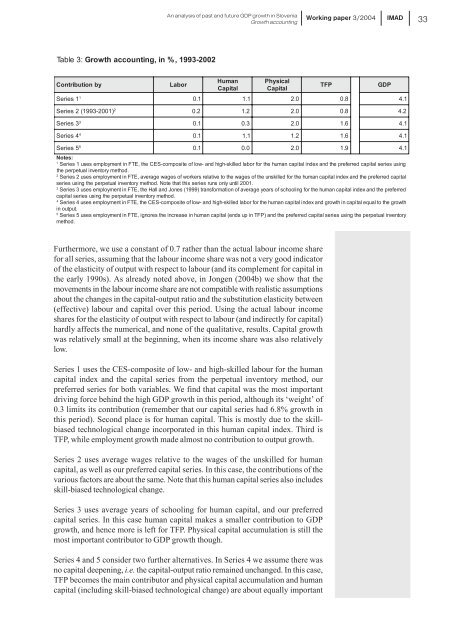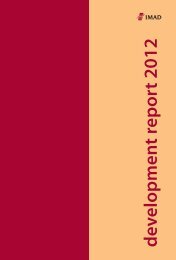Working papers published by IMAD ISSN: 1318-1920 ... - UMAR
Working papers published by IMAD ISSN: 1318-1920 ... - UMAR
Working papers published by IMAD ISSN: 1318-1920 ... - UMAR
You also want an ePaper? Increase the reach of your titles
YUMPU automatically turns print PDFs into web optimized ePapers that Google loves.
An analysis of past and future GDP growth in Slovenia<br />
Growth accounting<br />
<strong>Working</strong> paper 3/2004<br />
<strong>IMAD</strong><br />
33<br />
Table<br />
3: Growth accounting, in %, 1993-2002<br />
Contribution<br />
<strong>by</strong><br />
Labor<br />
Human<br />
Capital<br />
Physical<br />
Capital<br />
1<br />
Series<br />
1<br />
0.<br />
1<br />
1.<br />
1<br />
2.<br />
0<br />
0.<br />
8<br />
4. 1<br />
2<br />
Series<br />
2 (1993-2001)<br />
0.<br />
2<br />
1.<br />
2<br />
2.<br />
0<br />
0.<br />
8<br />
4. 2<br />
3<br />
Series<br />
3<br />
0.<br />
1<br />
0.<br />
3<br />
2.<br />
0<br />
1.<br />
6<br />
4. 1<br />
4<br />
Series<br />
4<br />
0.<br />
1<br />
1.<br />
1<br />
1.<br />
2<br />
1.<br />
6<br />
4. 1<br />
5<br />
Series<br />
5<br />
0.<br />
1<br />
0.<br />
0<br />
2.<br />
0<br />
1.<br />
9<br />
4. 1<br />
Notes:<br />
1 Series 1 uses employment in FTE, the CES-composite of low-<br />
and high-skilled labor for the human capital index and the preferred capital series usin g<br />
the perpetual inventory method.<br />
2 Series 2 uses employment in FTE, average wages of workers relative to the wages of the unskilled for the human capital index and the preferred capita l<br />
series using the perpetual inventory method. Note that this series runs only until 2001.<br />
3 Series 3 uses employment in FTE, the Hall and Jones (1999) transformation of average years of schooling for the human capital index and the preferre d<br />
capital series using the perpetual inventory method.<br />
4 Series 4 uses employment in FTE, the CES-composite of low-<br />
and high-skilled labor for the human capital index and growth in capital equal to the growt h<br />
in output.<br />
5 Series 5 uses employment in FTE, ignores the increase in human capital (ends up in TFP) and the preferred capital series using the perpetual inventor y<br />
method.<br />
TFP<br />
GDP<br />
Furthermore, we use a constant of 0.7 rather than the actual labour income share<br />
for all series, assuming that the labour income share was not a very good indicator<br />
of the elasticity of output with respect to labour (and its complement for capital in<br />
the early 1990s). As already noted above, in Jongen (2004b) we show that the<br />
movements in the labour income share are not compatible with realistic assumptions<br />
about the changes in the capital-output ratio and the substitution elasticity between<br />
(effective) labour and capital over this period. Using the actual labour income<br />
shares for the elasticity of output with respect to labour (and indirectly for capital)<br />
hardly affects the numerical, and none of the qualitative, results. Capital growth<br />
was relatively small at the beginning, when its income share was also relatively<br />
low.<br />
Series 1 uses the CES-composite of low- and high-skilled labour for the human<br />
capital index and the capital series from the perpetual inventory method, our<br />
preferred series for both variables. We find that capital was the most important<br />
driving force behind the high GDP growth in this period, although its ‘weight’ of<br />
0.3 limits its contribution (remember that our capital series had 6.8% growth in<br />
this period). Second place is for human capital. This is mostly due to the skillbiased<br />
technological change incorporated in this human capital index. Third is<br />
TFP, while employment growth made almost no contribution to output growth.<br />
Series 2 uses average wages relative to the wages of the unskilled for human<br />
capital, as well as our preferred capital series. In this case, the contributions of the<br />
various factors are about the same. Note that this human capital series also includes<br />
skill-biased technological change.<br />
Series 3 uses average years of schooling for human capital, and our preferred<br />
capital series. In this case human capital makes a smaller contribution to GDP<br />
growth, and hence more is left for TFP. Physical capital accumulation is still the<br />
most important contributor to GDP growth though.<br />
Series 4 and 5 consider two further alternatives. In Series 4 we assume there was<br />
no capital deepening, i.e. the capital-output ratio remained unchanged. In this case,<br />
TFP becomes the main contributor and physical capital accumulation and human<br />
capital (including skill-biased technological change) are about equally important
















